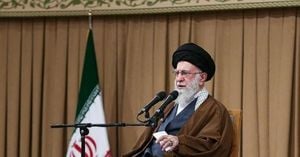In a world grappling with energy transitions, economic upheaval, and the urgent need for sustainable models, two stories—one from South America and another from the heart of the United States—offer a compelling glimpse into what’s possible when vision meets discipline. Uruguay, once on the brink of economic ruin, now leads South America in per capita income and renewable energy. Meanwhile, Utah County in the U.S. has just witnessed the launch of the Faraday Solar project, one of the largest utility-scale solar installations in the country, signaling a new era of clean energy investment and corporate responsibility.
Let’s rewind to 2002. Uruguay, a small nation often overshadowed by its larger neighbors, was staring down the barrel of economic collapse. According to the World Bank, the country’s GDP plummeted by about 11% in one year. Banks froze deposits, lines of credit vanished, and families lost decades of savings in mere weeks. Unemployment soared, poverty deepened, and the entire financial system teetered on the edge. It was, by all accounts, the kind of crisis that could scar a nation for generations—or worse, become a permanent fixture.
But Uruguay’s story took a different turn. Instead of resorting to short-term fixes or populist rhetoric, the country embarked on a path rarely chosen in Latin America: fiscal responsibility, structural reforms, and a steadfast commitment to institutional stability. The government prioritized shielding the financial system, establishing clear investment rules, and strengthening democracy. Regulatory predictability and long-term stability became the guiding lights. As the article in Globo points out, “No magic formula. No populist rhetoric. No monetary adventures.”
This wasn’t just about surviving the immediate storm. Uruguay’s leaders aimed to build an economy capable of weathering future tempests. The strategy didn’t change with each election cycle—a rarity in the region. Instead, term after term, the nation stuck to its guns, fostering an environment where trust and legal certainty became as valuable as any natural resource. Over the next two decades, Uruguay not only rebuilt itself but surpassed all its neighbors in per capita income, becoming a beacon of stability and progress in South America.
The second chapter of Uruguay’s transformation came in 2010, when the country made a bold bet on renewable energy. Massive investments poured into wind farms, agricultural biomass, hydroelectric modernization, solar systems, and intelligent transmission infrastructure. The results were nothing short of staggering. By around 2020, more than 95% of Uruguay’s electricity was generated from renewable sources—a figure that dwarfs the global average of 30% and even Brazil’s impressive 75-90% range, as reported by the World Bank.
This clean, stable, and affordable energy supply didn’t just lower Uruguay’s carbon footprint; it created fertile ground for innovation, technology, and digital infrastructure. While much of the world still debates its energy future, Uruguay is living it. Data centers, tech startups, and digital services have flourished, further boosting the nation’s economic resilience.
Education and digital access became the next frontier. In the 2010s, Uruguay rolled out a nationwide digital education initiative: internet access became universal in schools, every student received a laptop, and public services were digitized. Universities were integrated into technology hubs, and broadband connectivity reached nearly every corner of the country. Today, public documents and processes are digital, and the government operates with an efficiency rarely seen on the continent. As Globo notes, “Uruguay understood early on: Without technological education, a country cannot compete in the 21st century.”
Legal certainty and institutional trust have become Uruguay’s invisible yet invaluable assets. While neighboring countries swing between policy extremes with each election, Uruguay’s consistency has become a hallmark. Investors, both domestic and foreign, have taken notice. The end result? According to the latest World Bank data reported on November 3, 2025, Uruguay now leads South America in per capita income, macroeconomic stability, public digital education, institutional trust, renewable energy, quality of life, and governance. The gap with other Latin American countries is not just wide—it’s structural.
Meanwhile, on the other side of the equator, a different kind of energy revolution is unfolding. On November 3, 2025, Excelsior Energy Capital announced the start of commercial operations at the 685.3MWDC (525MWAC) Faraday Solar project in Utah County. This isn’t just another solar farm—it’s one of the largest utility-scale solar investments in the United States, according to Excelsior’s press release.
The Faraday Solar project is backed by a 20-year power purchase agreement with PacifiCorp under Rocky Mountain Power’s Schedule 34 green energy tariff. This innovative arrangement allows large customers to directly support renewable generation, and Meta (formerly Facebook) has agreed to purchase all the energy and associated environmental attributes from the project to match its Utah operations with clean power. That’s a major vote of confidence in the project’s impact and a signal to other corporations considering similar moves.
Excelsior acquired the project in 2023 from developers Parasol and Clenera, then steered it through financing, construction, and commissioning in under two years—a remarkable feat for a project of this scale. The solar array itself is vast: about 1.2 million solar panels spread across an area roughly the size of New York’s Central Park. Chris Frantz, Partner and Head of Portfolio Operations at Excelsior Energy Capital, remarked, “Successful delivery of this landmark project reaffirms Excelsior’s commitment to enabling others to reach their clean energy goals and support a clean and reliable grid.”
Dan Bove, Senior Director for Construction Management and Project Execution at Excelsior, added, “Delivering a project of this scale and complexity reflects the strength of our partnerships and our execution capabilities.” Key technical and commissioning support came from Energy Project Solutions and RES Group, while financial partners included U.S. Bancorp Impact Finance, MUFG, Nord/LB, Deutsche Bank, and a consortium of major lenders.
To mark the occasion, Excelsior will host a ribbon-cutting ceremony in Utah County on November 5, 2025, bringing together investors, community stakeholders, and local officials to celebrate the project’s completion. The Faraday Solar project, with its combination of scale, innovation, and corporate partnership, stands as a testament to what’s possible when public and private sectors align on the clean energy agenda.
Both Uruguay’s two-decade journey and the rapid deployment of Faraday Solar in Utah County offer lessons for a world at a crossroads. Uruguay’s success shows that even small nations can punch above their weight with vision, discipline, and continuity. Utah’s solar milestone demonstrates that large-scale clean energy is not just feasible but essential—and that corporate giants like Meta are willing to put their money where their mouth is.
As countries and communities everywhere confront the challenges of climate change, economic volatility, and digital transformation, these stories remind us: progress is possible, but it requires more than ambition. It demands commitment, partnership, and the courage to think—and act—long-term.



